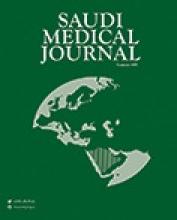Abstract
OBJECTIVE: This study focuses on the genetic aspect of beta-thalassemia among 88 at risk couples from the West Bank and Gaza, and the attitude of these couples toward prenatal diagnosis and its outcome as a preventive method.
METHODS: We tested 130 prenatal samples for beta-thalassemia during the period from January 1999 to July 2005. We performed prenatal diagnosis in these cases using the amplification refractory mutation system, as well as beta-globin gene sequencing as a conformational method. We drew a chorionic villus sample (CVS) for 1st trimester pregnant women and amniotic fluid (AF) for those in the 2nd trimester depending on the stage the pregnant woman contacted our lab.
RESULTS: The DNA analysis of 130 prenatal samples revealed 25 (19.2%) cases of beta-thalassemia major and 67 (51.5%) cases of beta-thalassemia carriers, while the remaining 38 (29.2%) were normal. The 25 affected fetuses were aborted according to the wishes of the parents. In the tested 88 couples, 14 mutations of beta-thalassemia were identified. These mutations and their frequencies were: IVSI-110 (22.2%), IVSI-6 (13.6%), Cd37 (12%), IVSI-I (9.7%), IVSII-1 (6.2%), Cd39 (9%), Cd6 (sickle cell mutation) (8.5%), Cd5 (8%), Cd8/9 (2.8%), Cd106/107 (2.8%), -30 promoter (1.1%), -88 promoter (1.1%), IVSI (-1) (2.3%) and IVSI-5 (0.6%). We found that in 77.3% of the couples, both the mother and the father carry the same type of mutation while 22.7% of them carry different mutations. We found 77.9% consanguinity among the couples
CONCLUSION: We found very good acceptability for prenatal diagnosis in beta-thalassemia afflicted families. All couples with affected fetuses opted for abortion. The spectrum of mutations in the tested couples revealed several similarities to neighboring countries with -88 promoter mutation reported for the first time in our region.
- Copyright: © Saudi Medical Journal
This is an open-access article distributed under the terms of the Creative Commons Attribution-Noncommercial-Share Alike 3.0 Unported, which permits unrestricted use, distribution, and reproduction in any medium, provided the original work is properly cited.






